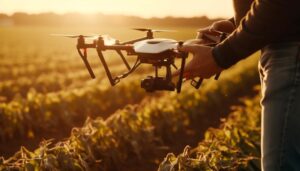Precision agriculture is a farm management approach using crucial technologies to improve yields across the entire farming operation. This practice permits you to be more accurate and controlled during all the stages of the cropping cycle, providing your crops the best chance to thrive.
At its core, precision agriculture depends on satellite positioning like the Global Positioning System (GPS) or more widely, Global Navigation Satellite Systems (GNSS) to identify the precise location of the farming vehicles or to pinpoint areas of the field. This location-based information is essential for everyday farming tasks such as guidance and field mapping. With sensors and other farm mapping tools, GPS positioning enables advanced precision farming tasks like crop health monitoring, variable rate seeding and fertilizer application, harvest monitoring and data collection.
Every field is different. The terrain, climate, soil properties, weather and farm management practices contribute to its performance. Individual areas within each plot can have substantial variability, causing yield fluctuations. By integrating precision farming technologies into your operation, you can address these variabilities to boost production. The higher the GPS/GNSS accuracy rate, the better the results you can achieve. A solid implementation of precision agriculture practices results in maximized yields, increased efficiencies, optimized inputs and labour, lower costs and higher profitability across your operation.

What are the acclaimed benefits of precision agriculture?
Precision agriculture holistically benefits all stages of farming – from planning phase throughout the growing cycle and till harvest. Because it provides invaluable real-time location-based information, you can always make informed decisions about your entire farming operations throughout the season and persistently keep improving.
Cost reduction
Saving on the costs is one of the key reasons to invest in precision agriculture technologies. Employing high-accuracy GPS/GNSS equipment with an automated steering solution minimizes fuel consumption and prolongs the equipment’s service. On a planter, it minimizes gaps and overlaps, eliminating seed wastage and avoiding unused land where seed was missed.
On a sprayer or spreader, it is possible to vary the rate of fertilizer applied to optimize usage. Since precision farming results in simplified and more efficient operations throughout the entire farming season, it can help to reduce the number of hours necessary in the field and the necessity of skilled labor.
Increased yields
Using precision farming practices to apply the correct amount of inputs to fields can yield healthier crops and achieve greater yields. More control over seeds, nutrients, water and other resources means less plant stress and a more incredible opportunity for them to thrive.
Also, by increasing the accuracy of your agricultural machines, you will make the most of the farm with optimal crop spacing, precise treatment application and accurate field mapping so you can make the wisest decisions for a healthier, more robust output.
Profitability
Higher efficiencies, reductions in input costs, greater crop quality and increased yields all lead to higher profitability on the farm. These benefits are possible by adopting the precision farm management techniques and technologies. By adding each precision farming practice and greater accuracy, profits can increase every season.
Sustainability
In farming, being a land steward means feeding more people while limiting the environmental impact. Precision agriculture leverages technologies to enhance complete sustainability throughout the farm by using critical resources more effectively. It’s about getting the best use of water, fertilizer, herbicides and fuel so you can use less to grow more.
Irrespective of how you farm today, implementing precision technologies can impact the land and other valuable resources.
Maximized land value
Today, arable farmland is scarce. It is typically your most valuable asset if you are lucky enough to own some. Its value is established by the potential profits that can be reaped, which also means every increase in productivity translates to more worth. But it’s not just productivity that alone makes farmland more attractive. The potential renters and buyers of a farm want to know that the plot was well taken care of. Land improvement and conservation projects like adequate drainage, terracing, waterways, and buffers contribute to the land’s success.
The adoption of precision farming practices has demonstrated less disruption in the valuable topsoil layer and enhanced soil health over time, making a plot of land more productive and sustainable. With the correct practices, your land can be valued at the highest standard for selling. To know more about this, please contact SoilOptix® today! Or visit https://soiloptix.com/ for more details!
